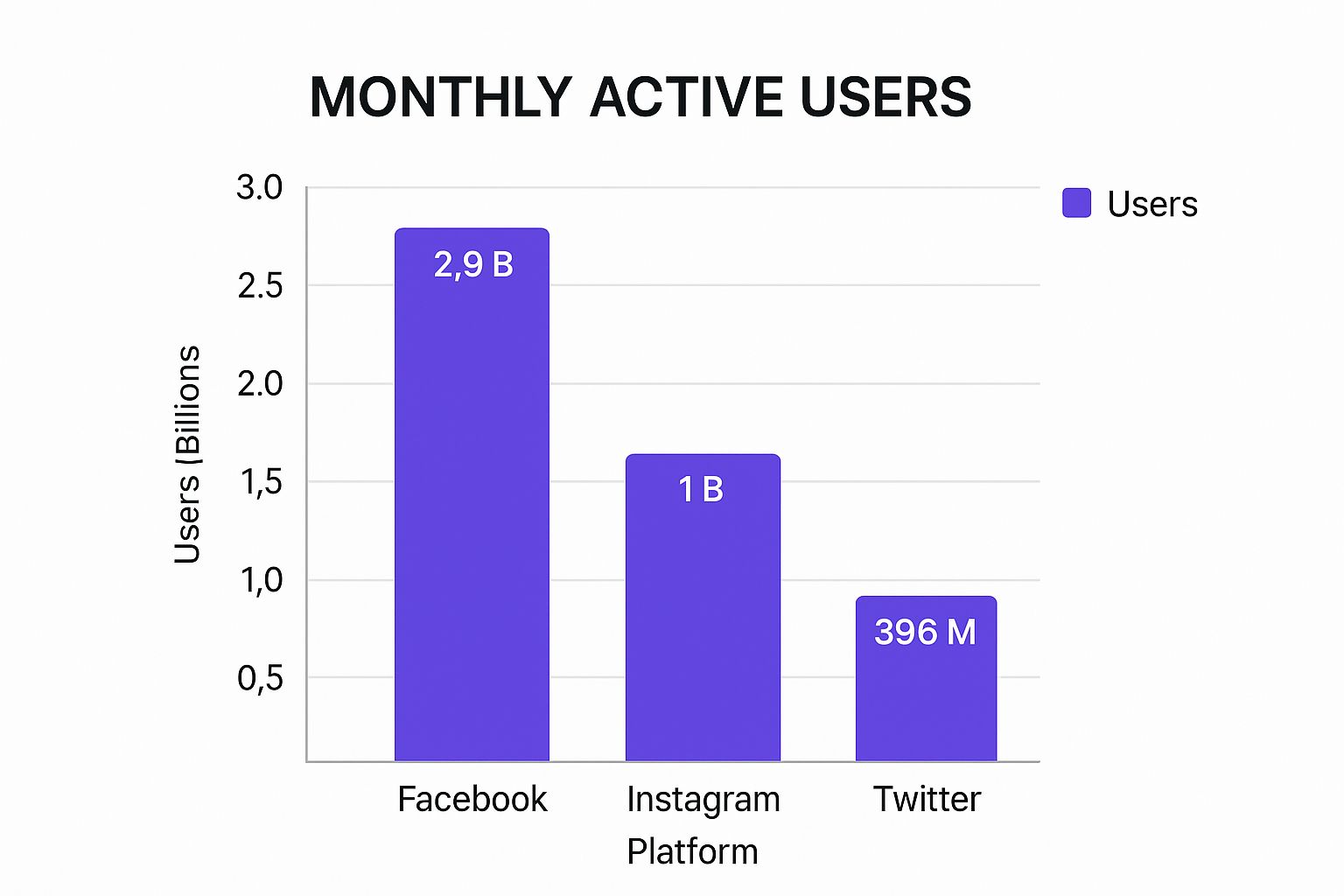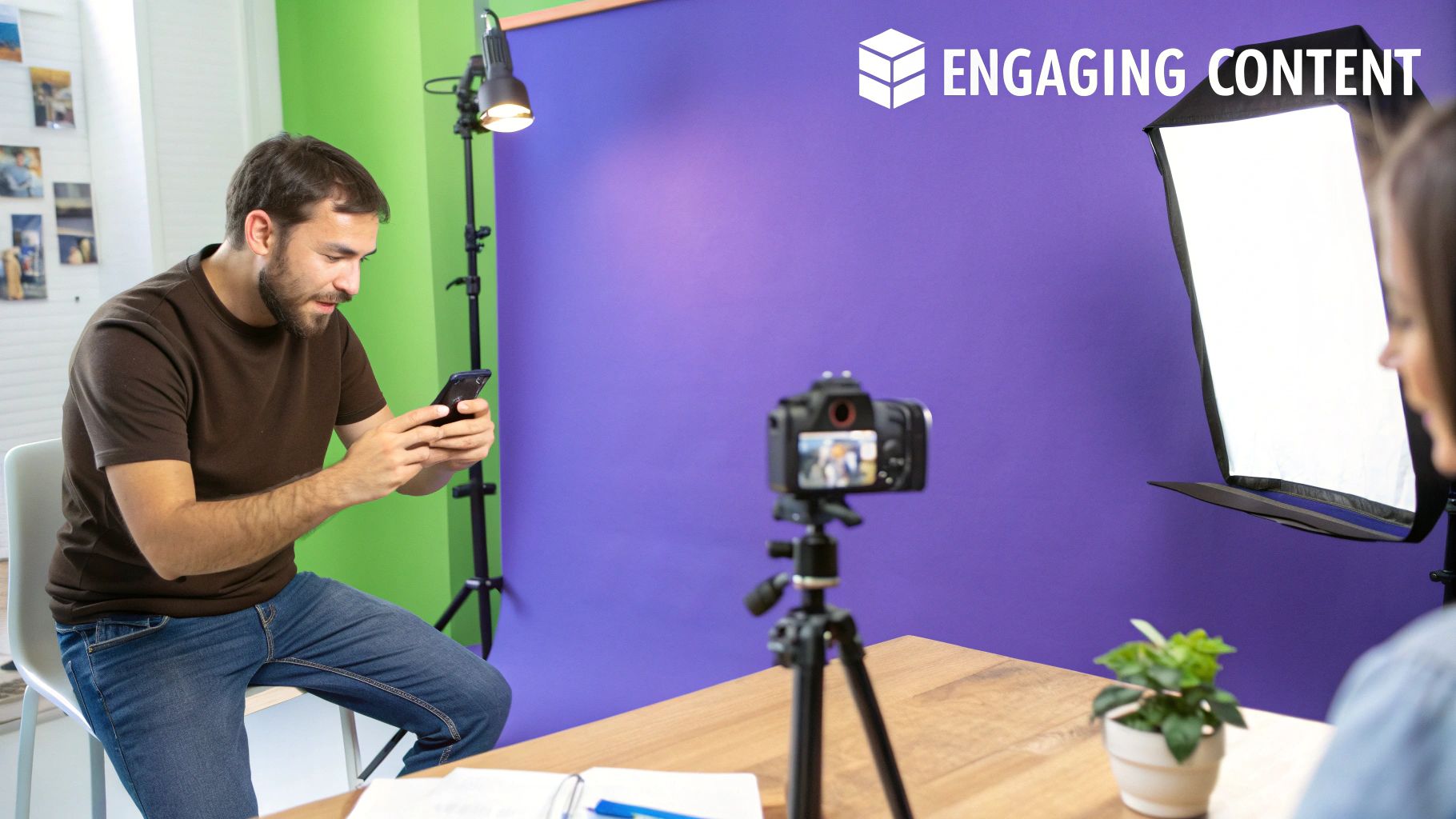How to Build Social Media Presence That Matters
Learn how to build social media presence with proven strategies. Discover how to build social media presence that drives engagement and growth for your brand.
Posted by
Trying to build a social media presence from scratch can feel like shouting into the void. It’s not just about chasing followers; it’s about turning your social channels into real business assets. The whole process really boils down to a few key actions: defining your audience, picking the right platforms, creating a smart plan, and then—the hard part—consistently posting stuff people actually care about.
This foundational work is what separates brands that thrive from those that just make noise.
Building Your Social Media Foundation
Before you can even think about viral moments or a massive follower count, you have to lay a solid groundwork. So many brands stumble right out of the gate because they skip this part, jumping straight to posting content without any real direction.
A strong foundation isn’t about being everywhere at once. It’s about showing up in the right places with the right message. This is where you get specific, digging deep into who your audience really is, what they care about, and where they hang out online.
Define Your Audience and Goals
First things first: forget about creating a profile. Your first move is to get crystal clear on who you're trying to reach. And I mean really clear. Go way beyond basic demographics like age and gender. What are your ideal customers' biggest headaches? What kind of content would make them stop scrolling and say, "Wow, this is for me"? Building out a detailed buyer persona is the single best thing you can do to guide every decision you make from here on out.
At the same time, you need to set goals you can actually measure. What does "success" on social media actually look like for your brand? Instead of vague ideas like "more engagement," get specific:
- Increase website traffic by 15% in the next quarter.
- Generate 20 qualified leads per month from LinkedIn.
- Boost brand mentions by 30% through community engagement.
These kinds of goals connect your daily social media grind directly to business outcomes, making sure every bit of effort is focused and impactful.
A common mistake I see all the time is brands aiming for followers instead of relationships. Trust me, a smaller, highly engaged community is always more valuable than a huge, passive audience. Focus on building trust and providing real value from day one.
Choose Your Platforms Wisely
You don't need to be on every single platform. In fact, spreading yourself too thin is a surefire recipe for burnout and mediocre results. The audience research you just did? That’s your treasure map—it will tell you exactly where to focus your energy.
Just look at the sheer numbers for some of the biggest platforms out there.

While Facebook’s size is impressive, the real key is matching the platform's user base and content style to your brand. For instance, knowing that Facebook, with its 3.065 billion monthly users, is dominated by the 25-34 age group (31.1% of its audience) makes it a no-brainer for brands targeting millennials. But what if your audience is younger, or more professional?
To help you decide, here’s a quick guide to matching your brand's goals with the platforms where you'll see the most impact.
Choosing the Right Platform for Your Brand
| Platform | Primary Audience | Best For | Key Content Format |
|---|---|---|---|
| Gen Z & Millennials (18-34) | Visual storytelling, e-commerce, lifestyle brands, influencer marketing | High-quality images, Reels, Stories, Carousels | |
| TikTok | Gen Z & Younger Millennials (16-24) | Entertainment, trends, user-generated content, creative expression | Short-form vertical video, sounds, duets |
| Millennials & Gen X (25-55+) | Community building, local business, broad audience reach, news | Videos, links to articles, user-generated content, Groups | |
| Professionals & B2B (25-49) | B2B lead generation, professional networking, industry leadership | Articles, text posts, professional video, infographics | |
| X (Twitter) | Millennials (25-49), Journalists, Tech | Real-time updates, news, customer service, public conversation | Short text updates, memes, video clips, polls |
| Millennial Women (25-44) | Inspiration, visual discovery, driving traffic to products/blogs | Visually appealing Pins (images & video), Idea Pins |
Ultimately, picking the right one or two platforms to master is far more effective than being a ghost on five of them.
To pull all of this together, your next step should be creating a simple plan. A good social media marketing plan template is the perfect tool for this. It helps you organize your goals, audience insights, and content strategy into a single, actionable guide, making your path to building a real presence so much clearer.
Creating Content That Connects and Converts

Alright, you know who you’re talking to and where they hang out online. Now for the fun part—the part where the real work begins. Your content is the currency of social media. It's the bridge you build between your brand and your audience, post by post.
Just posting to post? That’s not going to cut it. You need a strategy that delivers real, consistent value, or you're just shouting into the void.
Forget the pressure of dreaming up brand-new, earth-shattering ideas from scratch every single day. The secret that top creators and brands swear by is the content pillar method. It's a game-changer. The idea is to identify 3-5 broad topics or themes that are absolutely core to your brand and, more importantly, genuinely interesting to your audience.
Let's imagine a local coffee shop. Their pillars might look something like this:
- Behind-the-Scenes: Showing the journey from bean to cup or introducing the baristas who make the magic happen.
- Coffee Education: Sharing simple tips for brewing a better cup at home. No snobbery, just helpful advice.
- Community Spotlight: Featuring local artists, musicians, or events happening right there in the shop.
- Product Features: Highlighting a ridiculously good pastry or a new seasonal drink you just have to try.
See how that works? Each of these pillars can be spun into dozens of individual posts. A quick Reel of latte art, a carousel post breaking down different coffee grind sizes, a story introducing the "barista of the week"—the possibilities are endless. This approach keeps your feed fresh and varied without ever straying from what your brand is all about. It's the ultimate cure for content burnout.
Develop a Voice and Visual Style
Your content needs a personality. This is your brand voice. It’s how you sound online. Are you witty and a little sarcastic like Wendy's? Or are you more inspiring and motivational, like Nike? Whatever it is, it needs to be authentic to you and consistent everywhere. Talk to your audience like you're having a real conversation, not like you're reading from a corporate script.
Just as crucial is your visual identity. Social media feeds are crowded. Your visuals need to be thumb-stoppers. I don't mean every single photo has to be a professional masterpiece, but you do need a consistent look and feel.
Pro Tip: Create a simple style guide. Seriously, this helps so much. Define your main color palette (3-4 colors work best), pick 1-2 go-to fonts, and decide on a photo editing style (e.g., bright and airy vs. dark and moody). That consistency is what makes your brand instantly recognizable when someone is scrolling.
Plan Your Content for Consistency
Consistency is the engine that drives social media growth. It’s non-negotiable. Posting sporadically tells the algorithm—and your audience—that you aren't really committed. This is where a content calendar becomes your absolute best friend.
A simple calendar, whether it's a spreadsheet or a dedicated tool like EndorseFlow's scheduler, lets you plan your posts weeks ahead of time. It's your roadmap for mapping out your content pillars, scheduling promotions, and making sure you have a steady stream of great stuff going out. You can even use it to coordinate campaigns across different platforms.
And if you're really trying to nail a specific platform, it pays to dive into platform-specific tactics. For example, learning how to boost Facebook followers can give your broader strategy an extra edge.
This kind of planning frees you from that daily "Oh no, what do I post today?" panic. It lets you step back and focus on what really matters: creating high-quality, engaging content that turns followers into true fans and loyal customers.
Turning Followers Into a Thriving Community
Posting consistent content is a great start, but it's only half the battle. The real work—and the real magic—begins the moment after you hit "publish." This is where you stop broadcasting at people and start building a genuine, two-way conversation. It's how you turn a passive audience into a loyal community of advocates.
Think of your comment section as a goldmine of opportunity. Don't just heart a comment and move on. Ask follow-up questions. Tag users in your replies to create mini-conversations. If someone drops a compliment about your product, thank them for the specific detail they mentioned. And if someone offers criticism? Address it head-on, publicly and professionally. Showing you can handle feedback with grace builds an incredible amount of trust.
The goal is to make every single follower feel seen and heard. This isn't just customer service; it's community building. Every thoughtful reply tells your audience you actually care about them, not just their potential to buy something.
Spark Genuine Engagement
Going beyond simple replies is what separates a good social media presence from a great one. You have to proactively create reasons for people to interact with you and, just as importantly, with each other. It’s all about giving them a reason to talk.
Here are a few powerful ways I've seen this work:
- Host Live Q&As: Jump on Instagram or Facebook Live to answer questions in real-time. It’s unscripted, humanizes your brand, and delivers immediate value.
- Run Polls and Quizzes: Use the Stories features on most platforms to ask fun, relevant questions. This is a super low-effort way for followers to engage and gives you instant feedback on what they're thinking.
- Join Niche Conversations: Don't just hang out on your own page. Find relevant hashtags or groups in your industry and jump into the conversation. Offer your expertise without a sales pitch attached.
By mixing up these tactics, you create a much more dynamic and interesting space for your followers. If you're looking for more inspiration, we break down even more tactics in our complete guide to social media engagement strategies.
Leverage User-Generated Content
One of the most authentic forms of social proof is user-generated content (UGC). When a customer posts about your brand on their own, it’s a genuine endorsement that money just can't buy. Encourage this! Create a unique brand hashtag and run contests where users can submit photos or videos for a chance to be featured on your feed.
This approach does two things beautifully: it gives you a constant stream of authentic content and makes your customers feel like they're a real part of your brand’s story.
Building a community today also means being smart with your tools. With people spending over 14 billion hours on social media every day, the competition for attention is insane. It's no surprise that 73% of businesses using generative AI are seeing real bumps in their engagement rates. And as Talkwalker.com points out, teams that use social listening report up to twice the confidence in their marketing ROI. It just goes to show how technology can give you a serious edge in understanding and engaging with your audience.
Expanding Your Reach Beyond Organic Limits

Let's be honest: relying only on organic reach feels like a slow, uphill battle. While building a solid organic foundation is non-negotiable, if you really want to grow, you can't just sit back and wait for people to find you. It's time to get proactive.
This means shifting from passive posting to an assertive growth strategy. You have to put your brand in front of new faces, and that involves a smart mix of strategic hashtags, clever collaborations, and a little paid firepower.
Master Strategic Hashtagging
Think of hashtags as more than just a way to keyword-stuff your captions. They're powerful discovery tools that plug your content directly into conversations people are already having. But just slapping a massive tag like #marketing on your post is like shouting into a hurricane—you'll get lost in the noise instantly.
The real trick is to use a strategic mix of tags targeting different audience sizes. This approach helps you show up in the right places for the right people.
- Broad Tags: Use one or two high-volume tags (like
#digitalmarketing). These give you a quick, temporary burst of visibility. - Niche Tags: This is where the magic happens. Tags like
#smallbusinessmarketingtipshave way less competition and attract a much more qualified, interested audience. - Community Tags: Think of tags used by tight-knit groups or for specific challenges, like
#socialmediamanagerlife. Using these shows you're an active participant in the community, not just an outsider trying to sell something.
By blending these tag types, you strike a perfect balance between broad exposure and targeted discovery. Your content doesn't just reach more people—it reaches the right people who are far more likely to engage, follow, and convert.
Unlock Growth Through Collaboration
One of the absolute fastest ways to grow your social media presence is to get in front of someone else's audience. When you collaborate with influencers or even complementary brands, you introduce yourself to a warm, pre-built community that already trusts the source.
The key is finding partners whose audience is similar to yours but who aren't direct competitors. Imagine a graphic designer and a copywriter teaming up for a joint Instagram Live on creating killer ad creative. Both bring value, and both get priceless exposure to a new, highly relevant audience. In fact, effective social media management for small business often hinges on these kinds of partnerships to stretch reach without blowing the budget.
Amplify Your Best Content with Paid Ads
Paid social ads aren't just for mega-corporations with bottomless budgets. A small, targeted investment can pour gasoline on your growth fire. The secret? Amplify what’s already working.
Don't start from scratch. Take a look at your analytics and find your top-performing organic posts—the ones with the most likes, comments, and shares. These posts have already proven they resonate. By "boosting" them with even a small budget, you can push that proven content in front of thousands of new, highly targeted users based on their specific demographics, interests, and online behaviors. To truly scale, understanding the power of social media advertising is essential.
The opportunity here is staggering. As of mid-2025, there are roughly 5.41 billion active social media users across the globe—that's 65.7% of the world's population. With 7.6 new users hopping on every single second, this ever-expanding digital audience is ready and waiting for great content. You just have to make sure they see yours.
Using Analytics to Refine Your Strategy

You can't improve what you don't measure. It's an old saying, but it’s the absolute truth in social media. Without data, you’re just throwing content at the wall and hoping something sticks. You're guessing.
Looking at your analytics is how you stop guessing and start building a deliberate, effective strategy. It’s the most direct feedback loop you can get from your audience, showing you exactly what makes them stop scrolling and what sends them swiping away.
Identifying Metrics That Actually Matter
It’s easy to get distracted by vanity metrics. A huge follower count looks great on paper, but it doesn't pay the bills and it certainly doesn't tell you if your content is actually landing. To really understand what's going on, you have to dig deeper.
Focus on the numbers that signal genuine interest and action. These are the KPIs that give you a real-time pulse on your content's health:
- Engagement Rate: This is the big one. It measures your likes, comments, shares, and saves against your reach or follower count. A high rate means people aren't just seeing your content; they're connecting with it.
- Reach and Impressions: Think of reach as the number of unique people who saw your post. Impressions are the total number of times it was viewed (one person might see it multiple times). Tracking reach is your best gauge for how far your content is traveling.
- Click-Through Rate (CTR): If your post has a link, this is your money metric. It tells you how many people actually clicked to visit your website or landing page. It’s the clearest sign that your content is driving action.
- Audience Growth Rate: This isn’t about raw numbers; it’s about momentum. A steady, healthy growth rate shows your overall strategy is pulling in the right crowd.
By zeroing in on these indicators, you can move past the surface-level fluff and get to the heart of what’s actually working for your brand.
The most powerful insights often come from a simple comparison: pit your best-performing posts against your worst. What did the winners have in common? Was it the format (video vs. carousel), the caption style, or even the time of day you posted? Answering that question is the secret to making more of what your audience craves.
Conducting Regular Content Audits
A "content audit" might sound intimidating, but it’s really just a powerful monthly check-in with yourself. The whole point is to systematically review what you’ve done so you can spot trends and find hidden opportunities for the month ahead.
Here’s a simple way to approach it:
- Pull Your Data: At the end of the month, export the analytics for all your posts into a basic spreadsheet.
- Sort by Performance: Create columns for your key metrics—engagement rate, reach, CTR—and sort your content from best to worst for each one.
- Find the Patterns: Now, play detective. Are your carousels consistently earning more saves? Do Reels reach a totally new audience? Do captions that ask a question actually get more comments? Look for the common threads.
- Adjust and Experiment: Use what you've learned to guide next month's content calendar. If video is crushing it, it’s time to double down on Reels. If a certain type of post is consistently a dud, maybe it's time to retire it and test a new idea.
This is the data-driven feedback loop that separates the pros from the amateurs. It ensures that every month, your social media strategy gets a little smarter, a little sharper, and a lot more effective.
So, You've Got Questions About Building a Social Presence?
Look, jumping into social media for your brand can feel like you're trying to solve a puzzle with half the pieces missing. It’s totally normal to have questions pop up about how long this all takes, how often you should actually be posting, and what rookie mistakes will sink your efforts before you even start.
Getting a handle on these basics is what separates the brands that grow from the ones that fizzle out. Let's dig into some of the most common questions we hear from people trying to build a real presence online.
How Long Does It Take to Build a Real Social Media Presence?
This is the million-dollar question, isn't it? The honest-to-goodness answer is: it depends. I know, not what you wanted to hear. But there’s no magic switch to flip.
Generally speaking, you can expect to see real, meaningful traction—I’m talking about a loyal community, steady engagement, and a clear impact on your goals—within 6 to 12 months of consistent, smart effort.
What sways that timeline? A few big things:
- Your Niche: Trying to stand out in a saturated space like fashion or fitness? It's going to be a tougher, longer climb than if you're in a super-specific B2B tech niche.
- Content Quality: This is non-negotiable. High-value, genuinely interesting content will always, always speed up your growth. Mediocre, check-the-box posts just won't cut it.
- Your Engagement: Are you actually talking to people? Replying to comments? Starting conversations? Being an active participant is just as crucial as what you publish.
The most important thing to remember is that this is a marathon, not a sprint. The brands that win are the ones who show up consistently with real value. That will always beat a few flashy, one-off campaigns in the long run.
What’s the Magic Number for Posting Frequency?
Spoiler alert: there isn't one. The "perfect" posting schedule has way more to do with your specific audience and the platform you're on than some universal rule.
For example, a platform like X (formerly Twitter) is built for multiple updates a day. But if you’re trying to connect with professionals on LinkedIn, they'll probably appreciate 2-4 high-impact posts a week far more than daily noise.
A good starting point for channels like Instagram or Facebook is 3-5 times a week. But the golden rule here is quality over quantity. Three amazing posts will do more for you than seven generic ones. It's that simple.
Start with a schedule you know you can stick with, keep a close eye on your analytics, and let your audience's response guide your next move.
What Are the Biggest Mistakes I Should Avoid?
Knowing what not to do is half the battle. The single most common mistake we see is posting without a clear strategy—just throwing content at the wall to see what sticks. You have to know who you're talking to and what you're trying to achieve.
Another huge blunder? Making it all about you. Your social feed shouldn't just be a digital billboard for your products. If you’re not providing value and building real connections, you’re just making noise. People will tune you out fast.
Also, don't be that brand that ignores its community. Leaving comments and messages unanswered is a surefire way to kill trust and stop your growth in its tracks.
Finally, don't spread yourself too thin. It's so much better to dominate one or two platforms where your audience actually hangs out than to have a weak, inconsistent presence on five or six.
Ready to stop guessing and start growing? EndorseFlow combines automated testimonial collection with a powerful social media scheduler, helping you build a credible, consistent presence without the headache. Start your 14-day free trial and see the difference.